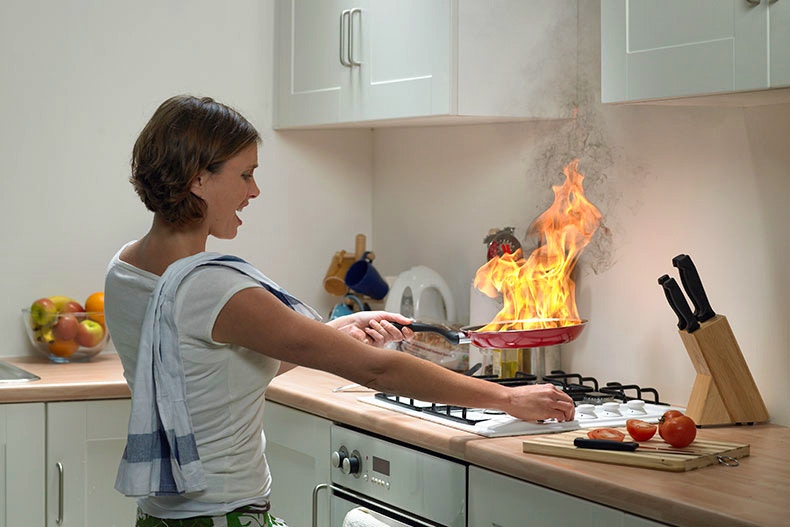Cooking is often a fun and rewarding experience, especially when the result is a delicious meal the whole family can enjoy. But did you know nearly half of all house fires start in the kitchen? And among kitchen fires, grease fires are the most dangerous and deadly.
To better protect yourself, your family, and your home, you need to know how to act if a grease fire ever occurs in your kitchen. Below we discuss the do’s and don’ts of how to put out a grease fire, as well as how to prevent a grease fire in the first place.
DON’TS for Grease Fires
Let’s get the don’ts out of the way first:
- Don’t extinguish with water: Whenever a fire occurs, our first intuition is to add water to quell the flames. However, because grease is oil, water reacts with it in a way that makes it splash, which will expand the flames.
- Don’t swat at the fire with fabrics: Grease fires often expand quickly. If you’re holding an apron or towel, you may think your best option is to swat at the fire. However, that is an incredibly dangerous move. For instance, you’ll be adding more oxygen to the fire, causing it to expand. Secondly, that object could easily catch on fire. And lastly, if you hit the pot or pan incorrectly, it could fly off the stove, and the flammable grease can land throughout the kitchen, making matters much worse.
- Don’t try to move the pot or pan outside: Even if you have oven mitts on, grease fires are unpredictable. There’s a significant chance you’ll burn yourself trying to move the fire. And if you drop the pot or pan while on the move, the fire will quickly expand in that area.
DO’S for Grease Fires:
If a grease fire ever occurs in your presence, here’s are some of the options you could use:Turn off the stove: Grease fires need three elements to occur; a heat source, a spark, and oxygen. If a grease fire ever breaks out, you want to turn off the heat source as quickly as possible.
- Turn off the stove: Grease fires need three elements to occur; a heat source, a spark, and oxygen. If a grease fire ever breaks out, you want to turn off the heat source as quickly as possible.
- Cover the flames with a lid or baking sheet: Since fires require oxygen, the best way to subdue a fire is to remove oxygen. By coving the grease fire with a lid, it will quickly burn up the remaining oxygen and should extinguish itself. If a grease fire occurs while baking, leave the oven closed and turn off the power.
- Douse the flames with baking soda or salt: Unlike water, baking soda and salt are much more effective at dousing grease fires. However, these remedies are better for smaller grease fires.
- Use a fire extinguisher: If all else fails, or the fire grows quickly, your best bet is to grab your fire extinguisher. The best fire extinguisher for grease fires is a Class K extinguisher, which we recommend having in your kitchen. However, if you don’t have a Class K extinguisher, use whichever fire extinguisher you have in your home.
- Get out and call 911: If you’re unable to extinguish the fire. Get yourself and everybody out of the house and call 911 immediately.
How to Prevent a Grease Fire
The best remedy for a house fire is avoiding them. When cooking at home, never leave the kitchen unattended. Fires can start and spread quickly, so you need to always be onsite to react quickly in case one occurs. Likewise, never cook grease above its recommended temperature, and carefully add food to hot oil. Frozen foods and hot oil are notorious for causing accidents, so be extra careful.
At ADS Security, home fire safety is one of our top priorities. If a fire breaks out in your home, we have systems that can alert you and emergency personnel immediately. If you would like to learn more, feel free to contact us today.
Categories: Fire, Safety Tips


